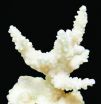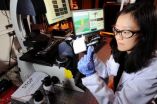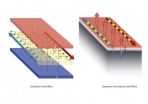(Press-News.org) The Caribbean islands have been pushed east over the last 50 million years, driven by the movement of the Earth's viscous mantle against the more rooted South American continent, reveals new research by geophysicists from USC.
The results, published today in Nature Geoscience, give us a better understanding of how continents resist the constant movement of the Earth's plates – and what effect the continental plates have on reshaping the surface of the Earth.
"Studying the deep earth interior provides insights into how the Earth has evolved into its present form," said Meghan S. Miller, assistant professor of earth sciences in the USC Dornsife College of Letters, Arts and Sciences, and lead author of the paper. "We're interested in plate tectonics, and the southeastern Caribbean is interesting because it's right near a complex plate boundary."
Miller and Thorsten W. Becker, associate professor of earth sciences at USC Dornsife College, studied the margin between the Caribbean plate and the South American plate, ringed by Haiti, the Dominican Republic, Puerto Rico and a crescent of smaller islands including Barbados and St. Lucia.
But just like the First Law of Ecology (and time travel), when it comes to the earth, everything really is connected. So to study the motion of the South American continent and Caribbean plate, the researchers had to first model the entire planet – 176 models to be exact, so large that they took several weeks to compute even at the USC High Performance Computing Center.
For most of us, earthquakes are something to be dreaded. But for Miller and Becker they are a necessary source of data, providing seismic waves that can be tracked all over the world to provide an image of the Earth's deep interior like a CAT scan. The earthquake waves move slower or more quickly depending on the temperature and composition of the rock, and also depending on how the crystals within the rocks align after millions of years of being pushed around in mantle convection.
"If you can, you want to solve the whole system and then zoom in," Becker said. "What's cool about this paper is that we didn't just run one or two models. We ran a lot, and it allowed us to explore different possibilities for how mantle flow might work."
Miller and Becker reconstructed the movement of the Earth's mantle to a depth of almost 3,000 kilometers, upending previous hypotheses of the seismic activity beneath the Caribbean Sea and providing an important new look at the unique tectonic interactions that are causing the Caribbean plate to tear away from South America.
In particular, Miller and Becker point to a part of the South American plate – known as a "cratonic keel" – that is roughly three times thicker than normal lithosphere and much stronger than typical mantle. The keel deflects and channels mantle flow, and provides an important snapshot of the strength of the continents compared to the rest of the Earth's outer layers.
"Oceanic plates are relatively simple, but if we want to understand how the Earth works as a system – and how faults evolved and where the flow is going over millions of years – we also have to understand continental plates," Becker said.
In the southeastern Caribbean, the interaction of the subducted plate beneath the Antilles island arc with the stronger continental keel has created the El Pilar-San Sebastian Fault, and the researchers believe a similar series of interactions may have formed the San Andreas Fault.
"We're studying the Caribbean, but our models are run for the entire globe," Miller said. "We can look at similar features in Japan, Southern California and the Mediterranean, anywhere we have instruments to record earthquakes."
###The research was funded by two National Science Foundation CAREER grants.
Meghan S. Miller and Thorsten W. Becker, "Mantle flow deflected by interactions between subducted slabs and cratonic keels," Nature Geoscience. DOI: 10.1038/NGEO1553.
Why do the Caribbean Islands arc?
Using earthquake data, USC earth scientists model the movement of the Earth to a depth of 3,000 km. and provide new insights into the strength of continents
2012-08-20
ELSE PRESS RELEASES FROM THIS DATE:
Experiment would test cloud geoengineering as way to slow warming
2012-08-20
Even though it sounds like science fiction, researchers are taking a second look at a controversial idea that uses futuristic ships to shoot salt water high into the sky over the oceans, creating clouds that reflect sunlight and thus counter global warming.
University of Washington atmospheric physicist Rob Wood describes a possible way to run an experiment to test the concept on a small scale in a comprehensive paper published this month in the journal Philosophical Transactions of the Royal Society.
The point of the paper -- which includes updates on the latest study ...
Psychologists link emotion to vividness of perception and creation of vivid memories
2012-08-20
TORONTO, ON – Have you ever wondered why you can remember things from long ago as if they happened yesterday, yet sometimes can't recall what you ate for dinner last night? According to a new study led by psychologists at the University of Toronto, it's because how much something means to you actually influences how you see it as well as how vividly you can recall it later.
"We've discovered that we see things that are emotionally arousing with greater clarity than those that are more mundane," says Rebecca Todd, a postdoctoral fellow in U of T's Department of Psychology ...
'DNA wires' could help physicians diagnose disease
2012-08-20
PHILADELPHIA, Aug. 19, 2012 — In a discovery that defies the popular meaning of the word "wire," scientists have found that Mother Nature uses DNA as a wire to detect the constantly occurring genetic damage and mistakes that ― if left unrepaired ― can result in diseases like cancer and underpin the physical and mental decline of aging.
That topic ― DNA wires and their potential use in identifying people at risk for certain diseases ― is the focus of a plenary talk here today during the 244th National Meeting & Exposition of the American Chemical ...
Meddling with male malaria mosquito 'mating plug' to control an epidemic
2012-08-20
PHILADELPHIA, Aug. 19, 2012 — Using information about the unique mating practices of the male malaria mosquito ― which, unlike any other insect, inserts a plug to seal its sperm inside the female ― scientists are zeroing in on a birth-control drug for Anopheles mosquitoes, deadly carriers of the disease that threatens 3 billion people, has infected more than 215 million and kills 655,000 annually.
They reported today at the 244th National Meeting & Exposition of the American Chemical Society on development of an approach for screening substances that could ...
Inspired by genetics, chemistry finally takes hold of its own code
2012-08-20
Stefan Matile opts for sincerity. For him, if organic chemistry is often fond of simplifying its functional systems, it is because it is mostly impossible for it to construct and manage molecular architectures as complex as those produced with tremendous efficiency in nature. "It's a fact", says the UNIGE professor and NCCR Chemical Biology member, "that we are far from being able to match the genius of nature."
Where the complexity arises
The specialist attributes the genetic code to this genius of nature. "It is rather simple because it is based on four foundations—adenine, ...
Improving water quality can help save coral reefs
2012-08-20
Research from the University of Southampton and the National Oceanography Centre, Southampton has found that an imbalance of nutrients in reef waters can increase the bleaching susceptibility of reef corals.
Corals are made up of many polyps that jointly form a layer of living tissue covering the calcareous skeletons. They depend on single-celled algae called zooxanthellae, which live within the coral polyps.
The coral animal and the associated zooxanthellae depend on each other for survival in a symbiotic relationship, where the coral supplies the algae with nutrients ...
Artificial intelligence helps detect subtle differences in mutant worms
2012-08-20
Research into the genetic factors behind certain disease mechanisms, illness progression and response to new drugs is frequently carried out using tiny multi-cellular animals such as nematodes, fruit flies or zebra fish.
Often, progress relies on the microscopic visual examination of many individual animals to detect mutants worthy of further study.
Now, scientists have demonstrated an automated system that uses artificial intelligence and cutting-edge image processing to rapidly examine large numbers of individual Caenorhabditis elegans, a species of nematode widely ...
A new route to dissipationless electronics
2012-08-20
A team of researchers at RIKEN and the University of Tokyo has demonstrated a new material that promises to eliminate loss in electrical power transmission. The surprise is that their methodology for solving this classic energy problem is based upon the first realization of a highly exotic type of magnetic semiconductor first theorized less than a decade ago - a magnetic topological insulator.
Development of energy saving technologies is one of the central pursuits of modern science. From advancing alternative energy resources like wind and solar power to improving the ...
The wasp that never cries wolf
2012-08-20
European paper wasps (Polistes dominula) advertise the size of their poison glands to potential predators, finds a new study published in BioMed Central's open access journal Frontiers in Zoology. The brighter the colour, the larger the poison gland.
Aposematism is used by many different animals to warn potential predators that they are poisonous. Usually this takes the form of distinctive colouration or patterns which predators quickly learn to avoid. Paper wasps have conspicuous yellow and black patterns covering their bodies and researchers from University of Granada ...
Massachusetts butterflies move north as climate warms
2012-08-20
PETERSHAM, Mass. (August 19, 2012)---The authors of a Harvard study published today in Nature Climate Change gathered their data from an unlikely source—the trip accounts of the Massachusetts Butterfly Club. Over the past 19 years, the amateur naturalist group has logged species counts on nearly 20,000 expeditions throughout Massachusetts. Their records fill a crucial gap in the scientific record.
Once analyzed, the data show a clear trend. According to Greg Breed, lead author on the study and a post-doctoral fellow at the Harvard Forest in Petersham, Mass., "Over the ...
LAST 30 PRESS RELEASES:
Neuroscientists devise formulas to measure multilingualism
New prostate cancer trial seeks to reduce toxicity without sacrificing efficacy
Geometry shapes life
A CRISPR screen reveals many previously unrecognized genes required for brain development and a new neurodevelopmental disorder
Hot flush treatment has anti-breast cancer activity, study finds
Securing AI systems against growing cybersecurity threats
Longest observation of an active solar region
Why nail-biting, procrastination and other self-sabotaging behaviors are rooted in survival instincts
Regional variations in mechanical properties of porcine leptomeninges
Artificial empathy in therapy and healthcare: advancements in interpersonal interaction technologies
Why some brains switch gears more efficiently than others
UVA’s Jundong Li wins ICDM’S 2025 Tao Li Award for data mining, machine learning
UVA’s low-power, high-performance computer power player Mircea Stan earns National Academy of Inventors fellowship
Not playing by the rules: USU researcher explores filamentous algae dynamics in rivers
Do our body clocks influence our risk of dementia?
Anthropologists offer new evidence of bipedalism in long-debated fossil discovery
Safer receipt paper from wood
Dosage-sensitive genes suggest no whole-genome duplications in ancestral angiosperm
First ancient human herpesvirus genomes document their deep history with humans
Why Some Bacteria Survive Antibiotics and How to Stop Them - New study reveals that bacteria can survive antibiotic treatment through two fundamentally different “shutdown modes”
UCLA study links scar healing to dangerous placenta condition
CHANGE-seq-BE finds off-target changes in the genome from base editors
The Journal of Nuclear Medicine Ahead-of-Print Tip Sheet: January 2, 2026
Delayed or absent first dose of measles, mumps, and rubella vaccination
Trends in US preterm birth rates by household income and race and ethnicity
Study identifies potential biomarker linked to progression and brain inflammation in multiple sclerosis
Many mothers in Norway do not show up for postnatal check-ups
Researchers want to find out why quick clay is so unstable
Superradiant spins show teamwork at the quantum scale
Cleveland Clinic Research links tumor bacteria to immunotherapy resistance in head and neck cancer
[Press-News.org] Why do the Caribbean Islands arc?Using earthquake data, USC earth scientists model the movement of the Earth to a depth of 3,000 km. and provide new insights into the strength of continents




